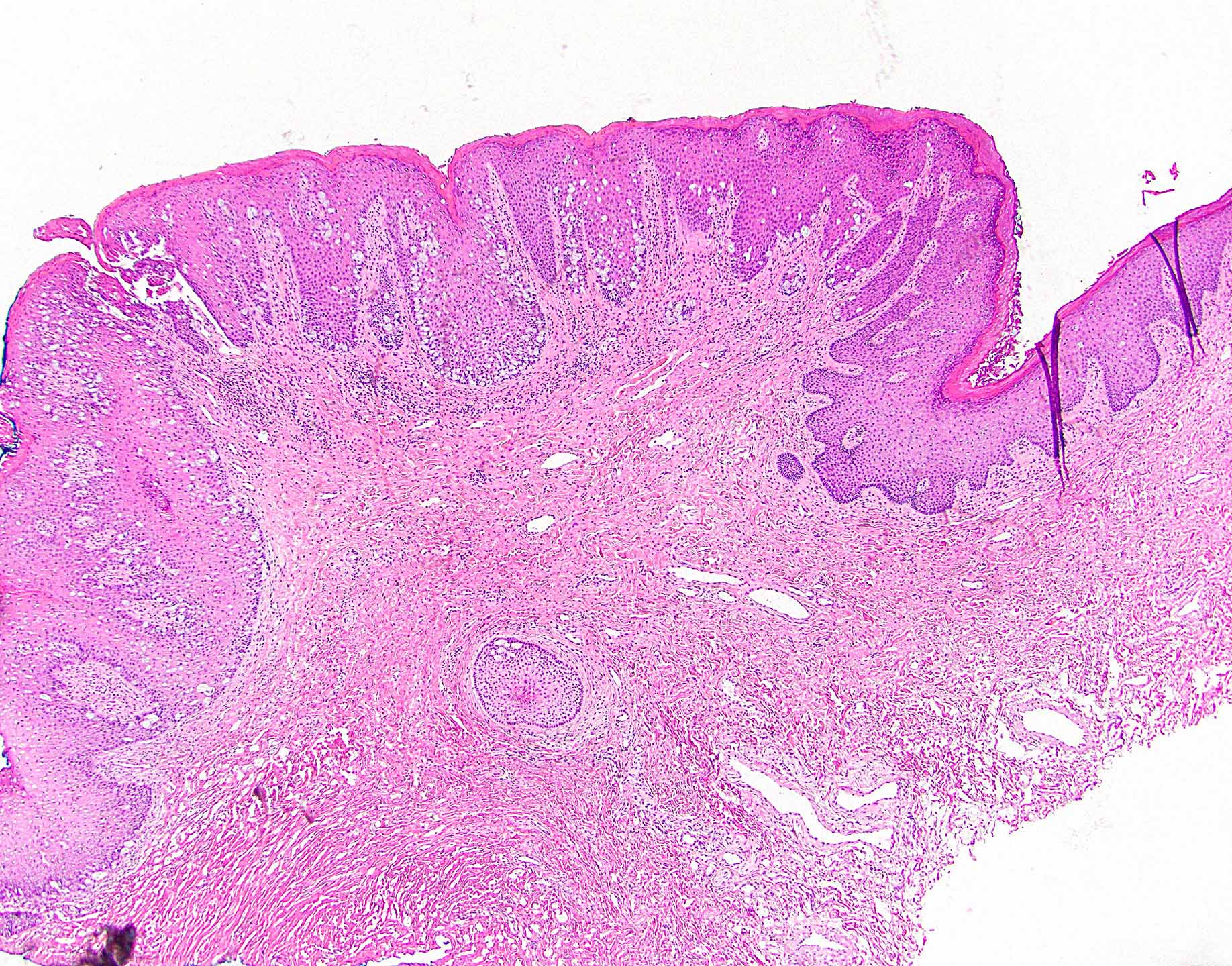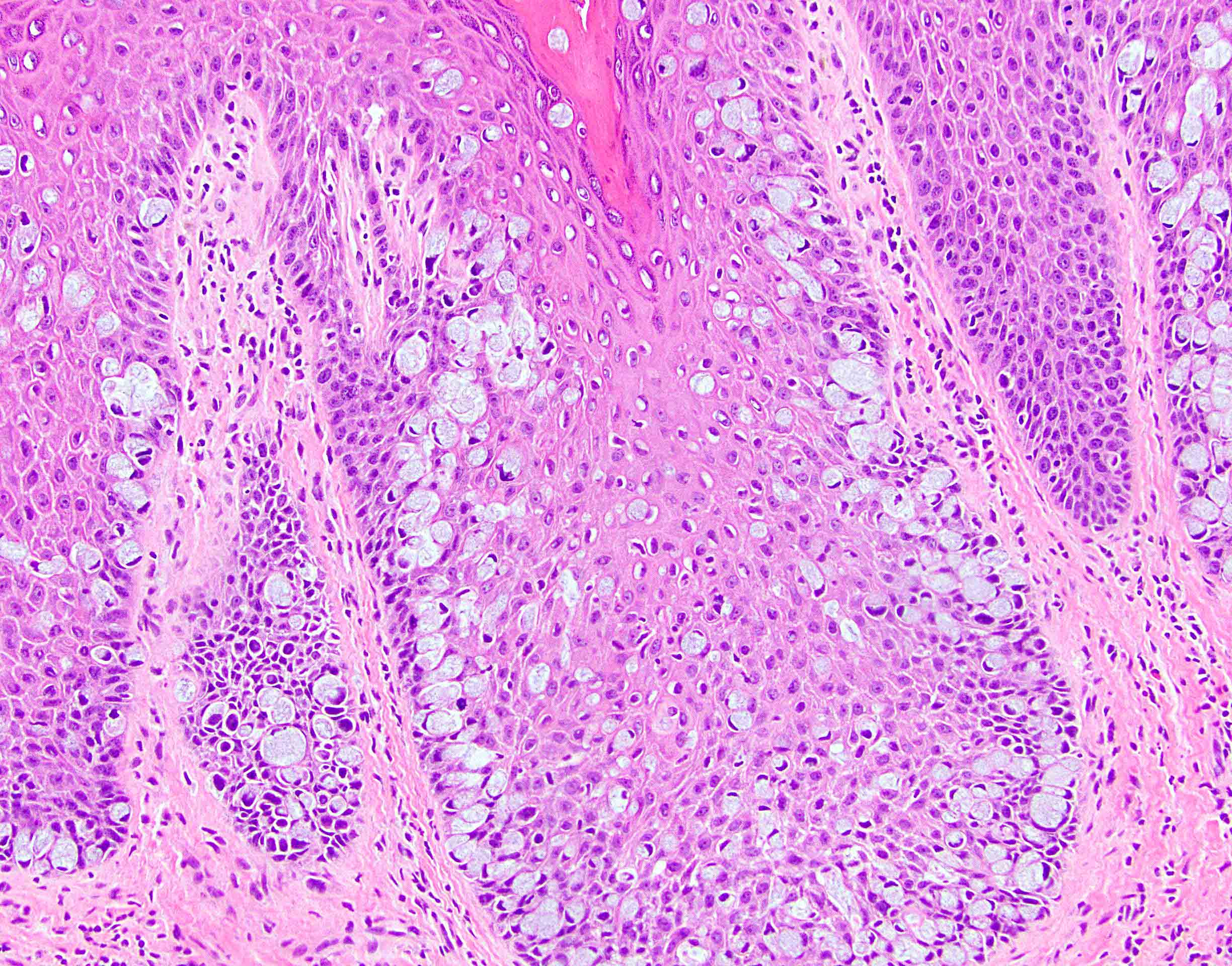Table of Contents
Definition / general | Essential features | Terminology | ICD coding | Epidemiology | Sites | Etiology | Diagnosis | Case reports | Treatment | Clinical images | Gross description | Microscopic (histologic) description | Microscopic (histologic) images | Positive stains | Negative stains | Sample pathology report | Differential diagnosis | Board review style question #1 | Board review style answer #1 | Board review style question #2 | Board review style answer #2Cite this page: Gonzalez RS. Paget disease. PathologyOutlines.com website. https://www.pathologyoutlines.com/topic/anuspagets.html. Accessed April 18th, 2024.
Definition / general
- Intraepithelial tumor usually of apocrine or possibly eccrine gland origin
Essential features
- Intraepidermal neoplastic cells, sometimes linked to anal malignancy (secondary) but may also be primary disease
- More common in older patients
- Most associated malignancies are adenocarcinoma but pagetoid spread of other carcinoma types can occur
Terminology
- Primary Paget disease: no association with underlying invasive malignancy
- Secondary Paget disease: related to intraepithelial spread of invasive malignancy
ICD coding
- ICD-10: C21.0 - malignant neoplasm of anus, unspecified
Epidemiology
- Primary extramammary anal Paget disease is rare
- Men and women are equally affected
- Most often occurs in the fifth to seventh decade
- Typically indolent but often recurs
- Up to 40% of patients with anal Paget disease have secondary disease (associated with an underlying malignancy); usually adenocarcinoma but sometimes other forms, such as neuroendocrine carcinoma (Colorectal Dis 2023 Mar 21 [Epub ahead of print], Pathol Int 2004;54:630)
Sites
- Arises anywhere between the dentate line and the perianal skin
Etiology
- May be related to epithelial - mesenchymal transition (Pathol Res Pract 2023;242:15434)
Diagnosis
- Tissue sampling
Case reports
- 64 year old man with perianal irritation (Int J Surg Case Rep 2012;3:483)
- 65 year old woman with perianal itching (Indian J Surg Oncol 2017;8:619)
- 72 year old woman with perianal bleeding (Dis Colon Rectum 2008;51:1842)
Treatment
- Wide local excision or radiotherapy (Surg Oncol 2011;20:e61, Curr Oncol 2012;19:e496)
Clinical images
Gross description
- Erythematous, ulcerated or eczematous plaques or patches
Microscopic (histologic) description
- Large, pale staining to clear intraepidermal neoplastic cells containing abundant mucin, arranged singly or occasionally in nests or gland-like formations
- Cells are more numerous basally
- Microscopic disease may extend beyond grossly visible changes
- Associated changes include squamous hyperplasia, fibroepithelioma-like hyperplasia and papillomatous hyperplasia (Am J Surg Pathol 2000;24:543)
- Pagetoid cells arising in association with a nonadenocarcinoma malignancy should have an appearance related to the causative malignancy (e.g., neuroendocrine carcinoma) (Pathol Int 2004;54:630)
Microscopic (histologic) images
Positive stains
- Mucicarmine, PAS, MUC5AC, GCDFP-15, CK7, CEA, EMA
- GCDFP-15 in primary disease; CDX2 in secondary disease (Diagn Pathol 2020;15:29)
- Immunophenotype may be different in unusual scenarios with secondary disease of nonanal origin (e.g., CK7 focally positive if related to rectal neoplasm) (Gastroenterology Res 2016;9:99)
Sample pathology report
- Anus, biopsy:
- Paget disease (see comment)
- Comment: The cells are positive for CK7 by immunohistochemistry, confirming the diagnosis. Anal Paget disease sometimes arises in the setting of an invasive anal malignancy. Further clinical workup may be indicated.
Differential diagnosis
- Atypical regenerative basal keratinocytes:
- Intercellular bridges
- Melanoma:
- Pagetoid spread by rectal adenocarcinoma:
- GCDFP-15 negative (Arch Pathol Lab Med 1998;122:1077)
- Squamous anal intraepithelial neoplasia:
- Therapy effect:
- Abnormal reactive cells are negative for CK7 and mucicarmine (Am J Surg Pathol 2018;42:1472)
Board review style question #1
Board review style answer #1
C. Anal Paget disease is positive for CK7 and mucicarmine. It is often but not always secondary, occurring alongside an invasive malignancy. It arises equally in men and women. Treatment related reactive changes may mimic Paget disease.
Comment Here
Reference: Anus & perianal area - Paget disease
Comment Here
Reference: Anus & perianal area - Paget disease
Board review style question #2
What is the typical behavior of anal Paget disease?
- It can metastasize even in the absence of adenocarcinoma
- It is generally indolent but may recur
- It spontaneously regresses
- It will always progress to invasive adenocarcinoma
Board review style answer #2
B. Anal Paget disease is generally indolent but may recur. Fewer than half of anal Paget disease cases are associated with invasive malignancy. It does not itself metastasize but it does not spontaneously regress either.
Comment Here
Reference: Anus & perianal area - Paget disease
Comment Here
Reference: Anus & perianal area - Paget disease







